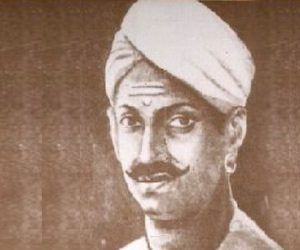19 July 1827
Birth of Mangal Pandey
What happened?

Mangal Pandey, the sepoy who played a major role in the incidents leading up to the First War of Indian Independence in 1857, was born on 19th July 1827 at Nagwa Village in modern-day Uttar Pradesh. Read on for more on Mangal Pandey and his role in the Indian Revolt for UPSC modern history segment.
Mangal Pandey Biography
- Mangal Pandey was born in an upper-caste Hindu family. His father was a landowning peasant.
- Pandey joined the British East India Company’s army as a young man of 22. He saw a career in the military as a means to succeed in life.
- He was a sepoy or soldier in the 6th Company of the 34th Bengal Native Infantry (BNI).
- There was a lot of unrest among sepoys of the Bengal army for a variety of reasons. This included differential treatment of Indian and British soldiers and grievances over the British policy of high taxation and land annexations. Many of the sepoys in the Bengal army were landowning farmers.
- There was also a suspicion among the minds of many sepoys that the British were intent on converting all of them to Christianity. For instance, an officer in the 34th BNI called Colonel Wheeler was a fanatical Christian preacher.
- The immediate cause of the unrest was a rumour that a new rifle (the Enfield P-53) which was to be introduced had a cartridge that was greased with the lard of pigs and cows, and that it had to be bitten off in order for the rifle to be discharged. The British officers did nothing substantial to quell this rumour.
- On 29th March 1857, the 34th BNI was stationed at Barrackpore. Mangal Pandey, carrying a loaded musket, was pacing about the parade ground and threatening to shoot the first European he saw. He also called upon the other sepoys to rebel.
- The adjutant of the regiment Lieutenant Baugh came upon the scene whereupon a scuffle ensued between him and Pandey after the latter took a shot at Baugh.
- Pandey is reported to have shouted to the soldiers, “You sent me out here, why don’t you follow me.”
- By this time, another officer Sergeant-Major Hewson and the other sepoys arrived. Hewson ordered an Indian officer Jemadar Ishwari Prasad to arrest Pandey but Prasad refused. Only one sepoy, Shaikh Paltu tried to help the British whereas the others remained mute spectators to the proceedings.
- After a while, the commanding officer of the regiment General Hearsey arrived on the scene and was able to evoke obedience from some of the men.
- Pandey shot himself in the chest but was not fatally injured. He was put on trial after his recovery.
- During the trial, he stated that he had acted on his own will and was neither under any drugs nor acting as per anybody else’s encouragement.
- Pandey was sentenced to death by hanging. The same punishment was awarded to Ishwari Prasad.
- Although the execution was scheduled to take place on 18th April, he was executed on 8th April 1857. Prasad was executed on 21st April.
- The 34th BNI was discharged ‘with disgrace’ on May 6th. Shaikh Paltu was promoted to Havildar but he was killed in the cantonment before the regiment had been disbanded.
- News of Pandey’s act of rebellion was well-known throughout the Bengal army and is thought to have been one of the factors that instigated the general mutiny afterwards. Mangal Pandey’s mutiny is considered the first act of mutiny by the sepoys in the 1857 Rebellion, which took the British more than a year and a half to suppress.
- Although Pandey was denounced by the British as a traitor, he is seen as a national hero among Indians. The Government of India considers him a freedom fighter and released a commemorative stamp in his honour in 1984.
See previous ‘This Day in History’ here.
Also See:
| Impact of the Revolt of 1857 | Social causes of the Revolt of 1857 |
| Military causes of the Revolt of 1857 |
Comments